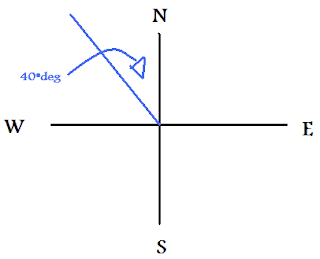There it was! "HE" locked my computer while I was in the middle of scribing. I really really don't like that. Actually I don't like any of it.
Interesting and Kinda Random:
 We see north as up because its conventional. That's just how it is. His point is were going to use these as directions, well, they are directions and were going to use them.
We see north as up because its conventional. That's just how it is. His point is were going to use these as directions, well, they are directions and were going to use them.
Measuring/Displaying Direction (this is what we started learning)
Ok, I didn't write down the notes and I don't have the screen shots or the video with me, only the examples, so these methods will truly be my interpretation (don't look at me if something's wrong).
I'll use the examples to explain the methods, somehow. 
Method 1: Look at which quadrant the line is in. When you write your answer you use the first cardinal (of that quadrant), state how far it goes to the next, then state the next (next meaning the other cardinal of that quadrant). So this would be E 19*deg S. You could also go the other way and say S 71*deg E, but everyone just likes the other way better.
Method 2: Is almost exactly the same as the first method only you write it like this, 19*deg S of E. You could also write it 71*deg E of S. I find it self explanatory when I write it like this.
 Method 3: I assumed in the first two methods you know how degrees relate with the cardinal directions. I'll just say this, one quadrant has 90*deg in it, so from north to south there are 180*deg and there are 360*deg in all. The third method is just that. All you would say for this is, 320*deg, because when you go from north to west its 270*deg then you have to add on 50 because there is 50 degrees till you reach the blue line (90 - 40 = 50).
Method 3: I assumed in the first two methods you know how degrees relate with the cardinal directions. I'll just say this, one quadrant has 90*deg in it, so from north to south there are 180*deg and there are 360*deg in all. The third method is just that. All you would say for this is, 320*deg, because when you go from north to west its 270*deg then you have to add on 50 because there is 50 degrees till you reach the blue line (90 - 40 = 50).
Orange Line: 188*deg, 8*deg W of S, 82*deg S of W, S 8*deg W, W 82*deg S
Purple Line: 79*deg, 11*deg N of E, 79*deg E of N, E 11*deg N, N 79*deg E
Homework = Ex. #1; 4-6. Ex. 2 #1-8. These won't be due till around the middle of next week (he'll be adding to it), and he wants us to use paper (graph paper) and pencil instead of Euklid (even though we will be using Euklid for most of this unit).
Oh, and the baseball diamond question (you know the really long one) is due for Monday. I don't mean to remind Max, but the chances of him forgetting are slim so I'll remind you instead.
Here is the video, and if you really want, here are the slides.
























